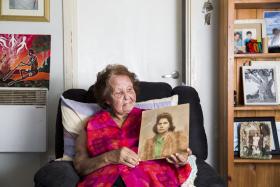Sydney elders: oral histories
Students will explore the importance of oral histories through an examination of the online exhibition Sydney Elders.
Key inquiry question #1
How did Australian society change throughout the twentieth century?
Key inquiry question #2
What contribution have significant individuals and groups made to the development of Australian society?
Learning Intention
Students are learning to:
- use and understand oral histories as an important historical source
- identify the contribution of Aboriginal people to Australian society
- investigate the experiences of people and determine what they reveal about how society has changed
Success criteria
Students will be successful when they can:
- use oral histories as sources
- describe the contribution to society made by these four Elders and their families
- explain how the stories of individuals reveal the changes in Australian society during the twentieth century
Student Activities
The role of Elders
Students will use an oral history source to learn about the contributions Indigenous people have made to society, and to investigate how society has changed throughout the 20th Century.

NSW Syllabus for the Australian Curriculum History K-10
HT3-3 identifies change and continuity and describes the causes and effects of change on Australian society
HT3-4 describes and explains the struggles for rights and freedoms in Australia, including Aboriginal and Torres Strait Islander peoples
HT3-5 applies a variety of skills of historical inquiry and communication
The contribution of individuals and groups, including Aboriginal people and/or Torres Strait Islanders and migrants, to the development of Australian society, for example in areas such as the economy, education, sciences, the arts, sport (ACHHK116)
- using a range of sources, research and describe the contribution of Aboriginal and Torres Strait Islander peoples and other groups to Australian society
Experiences of Australian democracy and citizenship, including the status and rights of Aboriginal people and/or Torres Strait Islanders, migrants, women and children (ACHHK114)
- examine Australian human rights, past and present, affecting Aboriginal and/or Torres Strait Islander peoples, migrants, women and children
- explain how Australian society has changed throughout the twentieth century for these groups
Comprehension: chronology, terms and concepts: respond, read and write to show understanding of historical matters
Analysis and use of sources: locate information relevant to inquiry questions in a range of sources
Explanation and communication: develop historical texts, particularly narratives and descriptions, which incorporate source material
Continuity and change: aspects of both continuity and change in Australian society over time
Cause and effect: some causes and effects of an historical event or development, eg migration to Australia
Perspectives: different points of view in the past and present, eg attitudes towards Federation
Significance: the importance of the contributions of individuals and groups to their times
Cross-curriculum priorities
- Aboriginal and Torres Strait Islander histories and cultures
General capabilities
- Intercultural understanding
- Civics and citizenship
- Difference and diversity
- Work and enterprise
Background notes for teachers and students
This online exhibition brings together content from Sydney Elders: Continuing Aboriginal Stories.
Curated by Jonathon Jones, the exhibition tells the personal story of Aboriginal Sydney through four of its traditional owners – Uncle Dennis Foley, Aunty Esme Timbery, Uncle Charles ‘Chicka’ Madden and Aunty Sandra Lee.
“Each elder represents different clans that have survived in Sydney,” says Jonathan.
“Together, they tell Sydney’s most important story, its Aboriginal story, and how they have continued the legacy of their ancestors by actively contributing to and creating Sydney.”
The Elders:
Uncle Charles ‘Chicka’ Madden, from Gadigal country, spent most of his life in construction, working on landmark projects, including Qantas House, Gladesville Bridge, Eastern Suburbs railway line and Carriageworks, and today is an active member of the Redfern community and artist.
Aunty Esme Timbery is a celebrated Bidjigal and Dharawal artist and elder from the Aboriginal mission community of La Perouse. Like her ancestors, she is a renowned shellwork artist whose work has been widely collected.
Uncle Dennis Foley, a Gai‐mariagal man from northern Sydney, worked in education and has published a book on his country, Repossession of Our Spirit: Traditional Owners of Northern Sydney.
Aunty Sandra Lee, a Dharug elder from Blacktown, is an active member of the Western Sydney Aboriginal community who is constantly pushing for recognition of Dharug people.